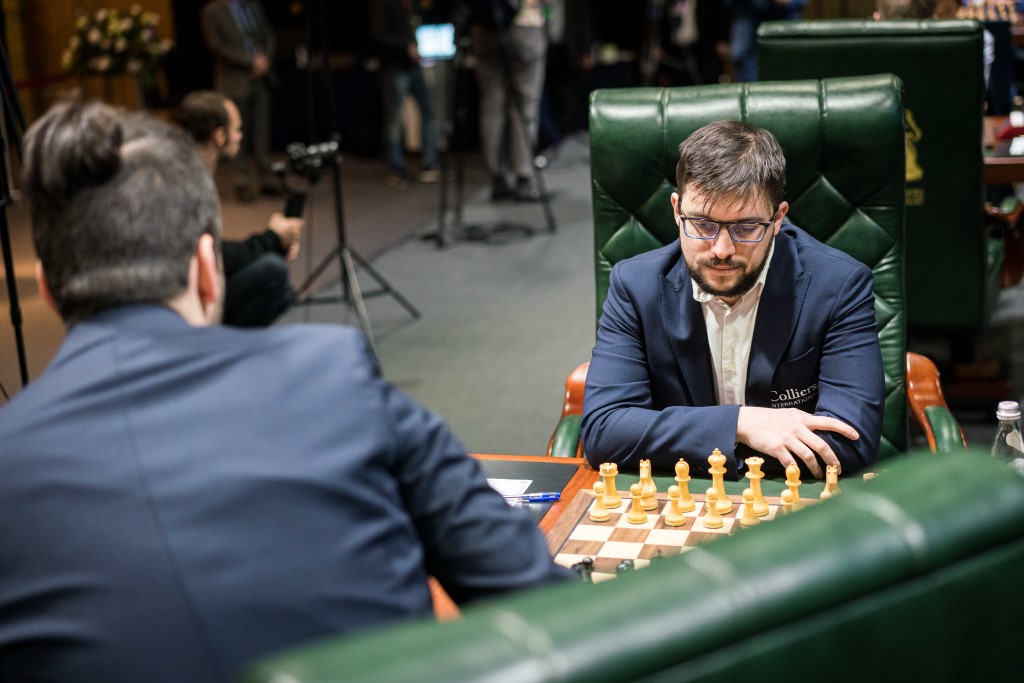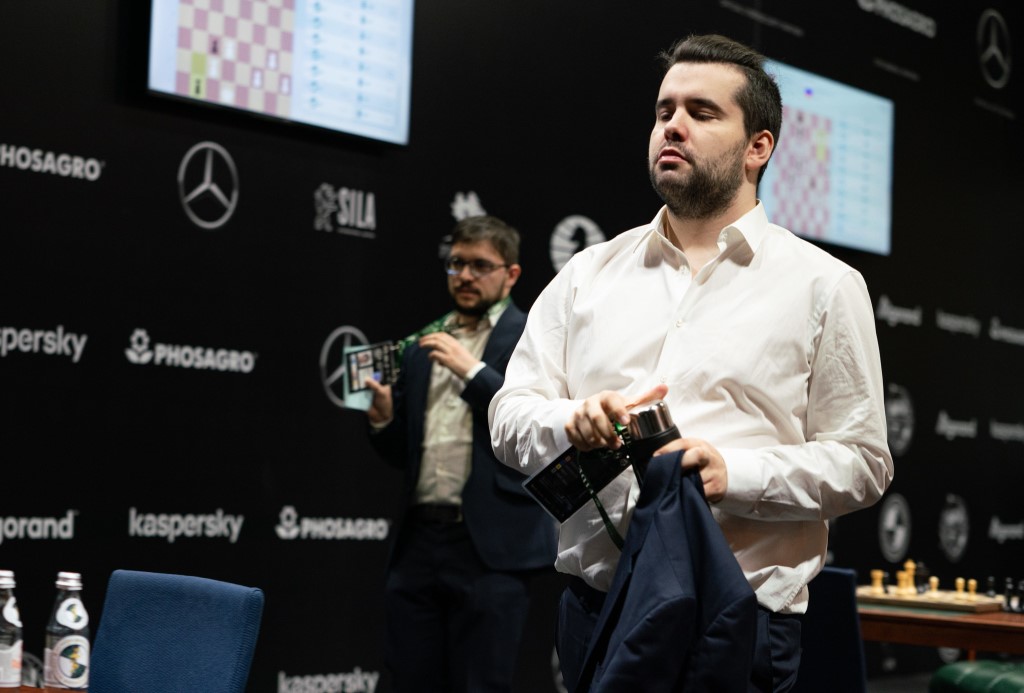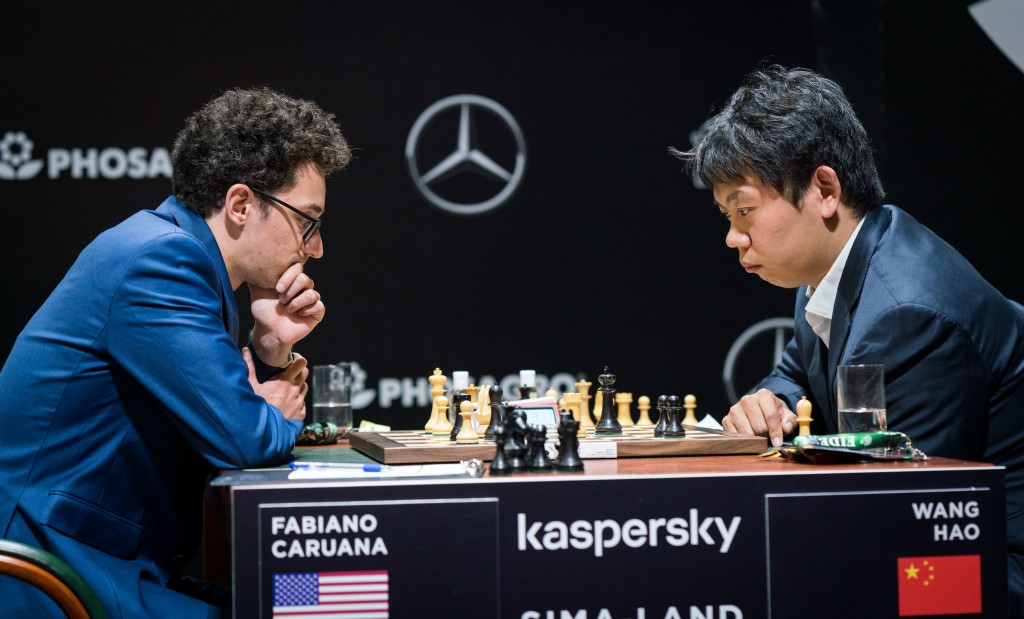


The eight-player Candidates tournament is one of the most prestigious global chess events, held every two years. The event will determine who will challenge the defender Magnus Carlsen for the title of the World Chess Champion. This year’s event has a prize fund of 500,000 Euros, which is the highest ever in the history of the Candidates tournaments.
All the results from round seven:
| Name | Result | Name |
| Caruana Fabiano | ½ - ½ | Wang Hao |
| Vachier-Lagrave Maxime | 1 - 0 | Nepomniachtchi Ian |
| Ding Liren | ½ - ½ | Alekseenko Kirill |
| Giri Anish | ½ - ½ | Grischuk Alexander |
Round eight takes place on Thursday, March 26 at 4:00 p.m. local time. Pairings:
| Name | Result | Name |
| Caruana Fabiano | Vachier-Lagrave Maxime | |
| Wang Hao | Ding Liren | |
| Nepomniachtchi Ian | Giri Anish | |
| Alekseenko Kirill | Grischuk Alexander |
The key encounter of round seven was the one that finished decisively, as Maxime Vachier-Lagrave caught up with Ian Nepomniachtchi in the standings by beating him with the white pieces in their direct face-off. 'Nepo' employed the Winawer Variation of the French Defence for a second time in Yekaterinburg and was duly outplayed after incorrectly deciding to close the structure on the queenside.
Nepomniachtchi's defeat reminds us of his backset at the Croatian leg of the Grand Chess Tour last year, when he started with three straight wins and went on to give up the lead by losing in rounds six and seven. Maxime Vachier-Lagrave's win against Nepomniachtchi could also be crucial should Vachier-Lagrave and Nepomniachtchi share first place at the end of this tournament: in this case Vachier-Lagrave would win the tournament on tie-break.
To quote the Candidates Tournament Regulations on tie-breaks:
If of two (2) or more players score the same number of points, the tie is decided by the following criteria, in order of priority:
a)The results of the games between the players involved in the tie.
b) Each tied player’s total number of wins in the tournament.
c) Sonneborn-Berger System.
After the first half of the tournament two players still remain undefeated: Vachier-Lagrave and Alexander Grischuk, who drew all seven of his games.
The remaining games of the round finished drawn. Fabiano Caruana could not get much against Wang Hao's Petroff Defence, Alexander Grischuk found a couple of critical moves to neutralize Anish Giri's new idea in the opening, and Ding Liren was disappointed with his play after needing to defend an inferior position with White against Kirill Alekseenko.

In contrasting moods — co-leaders Nepomniachtchi and Vachier-Lagrave leaving the stage | Photo: Maria Emelianova / FIDE
By now we are already used to see an almost invariable set of openings at elite events — particularly the Candidates Tournaments and the World Championship matches. Berlins, Najdorfs, Petroffs, Italians and Slavs are intensely prepared by super-strong teams of grandmasters working for the protagonists. Seldom do we see these players using the Caro-Kann, the Pirc (unless when in absolute need of a win with Black) or the Scandinavian, to name a few. In Yekateriburg, however, Nepomniachtchi has already employed the French Winawer twice — not as a one-off surprise weapon.
Against Alekseenko in round three, 'Nepo' did get a strategic edge, although his opponent also missed a tactical shot that might have completely changed the course of the event, while in his match-up against Vachier-Lagrave he was the one on the back foot from a rather early stage:
In the post-game interview, Vachier-Lagrave mentioned that he did not really expect his opponent to play the French, but that he was prepared for it given he had already used it against Alekseenko. He was also critical of his rival's decision to play 18...c4 here, explaining that usually closing the queenside makes sense for Black, except that here White is in time to advance his f and g-pawns — as was seen in the game — targeting the fairly vulnerable black monarch.
Vachier-Lagrave was happy with the way he handled his advantage, noting that his 35th move was important during the conversion:
As 'MVL' explained, 35.♕a1 prevents Black from advancing his passer on the queenside while threatening to infiltrate the black position. The Frenchman showcased his calculation abilities to force Nepomniachtchi's resignation on move 42. He was satisfied with his performance:
The important thing is to play well, and so far, apart from the game against Wang Hao, I think I played reasonably well. So far I'm quite happy and I hope to continue this trend.

The man of the hour | Photo: Lennart Ootes / FIDE
The players repeated nine moves from a Tomashevsky v Grischuk game from last year's World Blitz Championship. Not surprisingly, Giri had something ready against this line, showing what he called 'an interesting new idea' with 10.♘e3. Grischuk thought for almost half an hour before responding with 10...h5, which Giri thought was, in fact, a very difficult move to make. After 11.d4 exd3 12.exd3, the Russian played another 'sophisticated move' (Giri):
Grischuk spent six minutes on 12...♛d4, and White had trouble looking for some way to create an imbalance in his favour. In the end, a well-played game left each player with half a point.
With his trademark sense of humour, Giri noted that perhaps he was not really looking for a win, as his opponent has drawn all his games so far and is 'threatening' to repeat his feat of drawing all fourteen games in a Candidates event:
I had a conflict of interests, because on the one hand I wanted to win of course, but on the other I wanted Alexander to make all the draws, so the spirit left from within me towards him.

Two of the strongest interviewees in the chess world | Photo: Lennart Ootes / FIDE
Wang Hao played the Petroff once again, and entered a line which Caruana himself had employed to draw Magnus Carlsen at the 2018 World Championship match. As the American explained, the variation is not very popular despite being very good, as White can only choose between entering an endgame — as happened in the game — or playing very sharp lines that need to be precisely remembered.
Wang's 21st move was praises by his opponent:
21...♚f7 is the kind of move that perhaps would not cross many amateur players' minds. From this point on, Caruana started playing slightly carelessly and eventually needed to be precise to maintain the balance. Wang did not feel he had realistic winning chances, and the draw was signed after 41 moves.

Caruana and Wang Hao are two of four players currently on fifty percent | Photo: Lennart Ootes / FIDE
Ding's woes continue in Yekaterinburg, as he is not being able to find his usual flow at the event. The Chinese star called this 'not a good game', confessing that he had missed Alekseenko's reply on move 21:
After spending close to 45 minutes on his last three decisions, Ding found himself having to invest other 11 minutes after his opponent blitzed out 21...c5 — he had simply failed to assess this alternative adequately. Alekseenko later said he was very happy with his position at this point, but Ding quickly adjusted his play and started to find correct defensive manoeuvres to keep things under control.
When asked to evaluate his performance so far, Ding did not hide his disappointment while referring to the fact that the tournament could be interrupted at any moment:
My play was very bad. [...] I don't know whether the tournament will end somewhere, but I hope so.

It is not at all easy to face the best in the world on a daily basis | Photo: Lennart Ootes / FIDE
IM Merijn van Delft chose Vachier-Lagrave's win as the Game of the Week, while GM Simon Williams recapped the remaining encounters of the day.
Game of the Week #405 by IM Merijn van Delft
GM Simon Williams reviews the action of the day
Commentary by Evgenij Miroshnichenko and Daniil Dubov